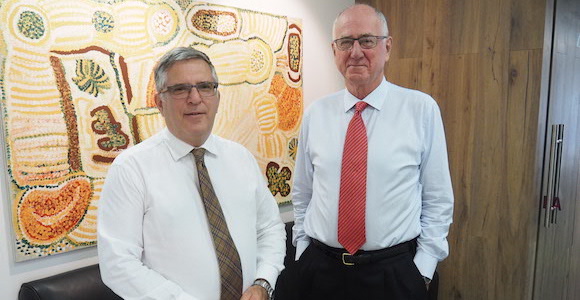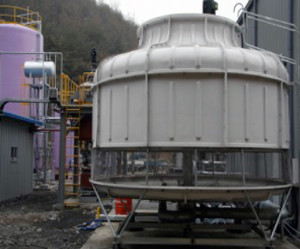Waste conversion company Landfill Energies is proposing to construct a plant in Port Moresby to turn municipal solid waste into electricity and diesel fuel. The company says it has a contract with PNG Power to provide electricity and intends to commence in early 2017.

Landfill Energies’ Michael Lanyon (left) and Del Smeeton.
Landfill Energies Director Del Smeeton says the project will have two benefits: the provision of comparatively cheap energy and much needed improvements to the environment.
The plant converts waste into electricity using a process called pyrolysis. ‘It is sorted mechanically to get rocks and glass out.’
The technology the company uses converts waste into energy using a process called pyrolysis.
‘It is sorted mechanically to get rocks and glass out,’ says Smeeton. ‘Then it goes into a big processing plant which has no oxygen and very high temperatures. Tyres are terrific. If you burn a tyre it really burns; you get a lot of fuel. Plastics are great. Anything that is organic can be processed.
‘There is a chemical decomposition of the waste which produces gas that runs the turbine. And fuel-oil is distilled to make diesel. Plus, there is a residue of good quality fertilizer.’
Smeeton was trained as an architect but works mainly in project management for large infrastructure projects. In PNG he was involved in project management for Exxon Mobil’s Komo airport, and the National Youth Development Institute. ‘I have worked all around the world, but I want to concentrate on PNG,’ he says, adding that his grandfather was a missionary in PNG and he spent much of his childhood in the country.
The technology was devised by Dutch company Global Green International. Smeeton says the technology has been used for 30 years, but its efficiency has been greatly improved. The proposed plant will process 20 tonnes of dry waste per day, which converts into 2 megawatts of base load power and 10,000 litres of diesel.
Costs competitive
Smeeton says the power is produced at an efficient cost. This is marginally more expensive than power produced from liquefied natural gas (LNG), but considerably cheaper than power produced from diesel, which is very expensive and damaging to the environment.
‘We had to compete with LNG gas,’ says Smeeton. ‘(PNG has) hydro power, and power produced by an old diesel generator, which is horrifically expensive and creates very bad pollution.
‘PNG Power are paying a little bit more, but it is solving other problems for them. I think they are really doing it because once you get into remoter areas the cost of power becomes very expensive.’
The proposed timeline is to get physical planning approval in April, to commence construction in May and to complete construction by December. The company wants to raise the necessary capital by May.
PNG capital raising
Michael Lanyon, a lawyer and Director of Landfill Energies, says the strategy will be to raise the capital within PNG.
‘If you try do it outside, you have to explain PNG risks as well as the plant risks. If you can borrow in PNG then all you have to do is explain the plant risks. There might be an equity proportion as well. (We want) to raise something in excess of US$12 million (K36.4 million).’
Smeeton says the plant is manufactured in Japan and shipped in 40 foot containers. Capacity is expanded by attaching extra modules. The company will bring in the plant and equipment and train local employees to use it.
Smeeton says he wants to establish two sites in Port Moresby, then roll out further plant in Lae or Wewak, where more renewable power is needed.
‘What PNG Power have said is: “get this first one up and running and you get a look at any of the other regions.” They want to see how it works.’
A base load solution

One of Landfill Energies’ modules
Smeeton says unlike some forms of renewable energy the plant produces continuous, base load power. There is no need to connect to a substation; the plant is connected directly to high-powered wires.
Lanyon hopes that in five years time to have five or more modules running. He says one threat is that, as batteries improve, solar will become more viable.
‘But the power isn’t the primary reason for doing it, it is to reduce landfill,’ he says. ‘We are not going to run out of rubbish. So I think that means there will always be a need for this.’
‘We go and look at tips. It is fantastic. A very exciting time.’
Smeeton says his hope is to set up many smaller, five-tonne plants, around the island. ‘They all need power and they all have rubbish. The landfill is a real problem that they have to solve.’
The emissions are below Australian Environmental Protection Authority standards, claims Smeeton, who also noted that coming to an agreement with PNG Power was relatively straightforward.
‘We only dealt with PNG Power. They have been good. We achieved a power purchase agreement in 12 months which everyone says was very good. So we are happy. We have no dealing with other government departments. They wrote some special documentation for us, they were very good.’
Landon says his company is excited about making a positive contribution to Papua New Guinea’s waste and power issues: ‘We go and look at tips. It is fantastic. A very exciting time.’








Speak Your Mind